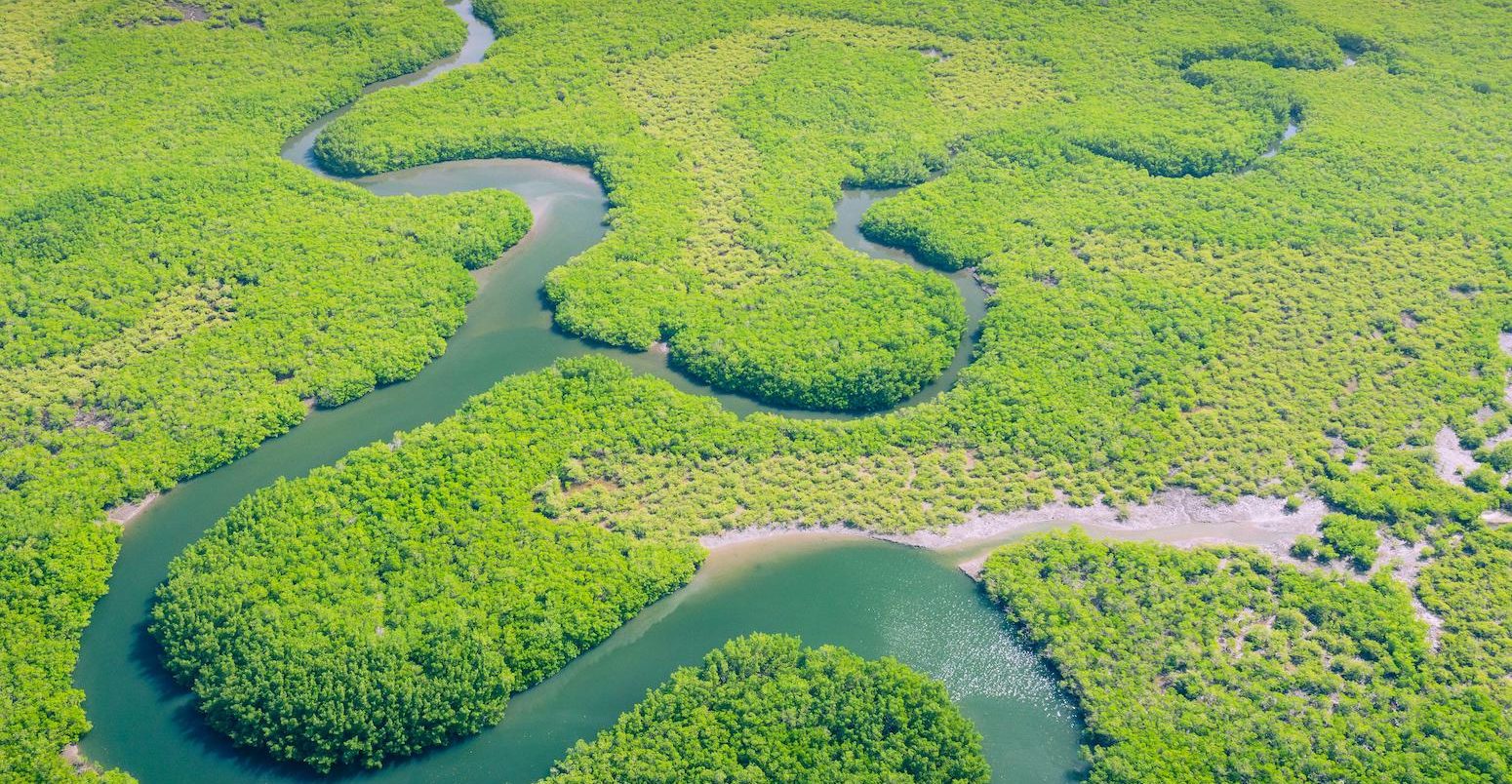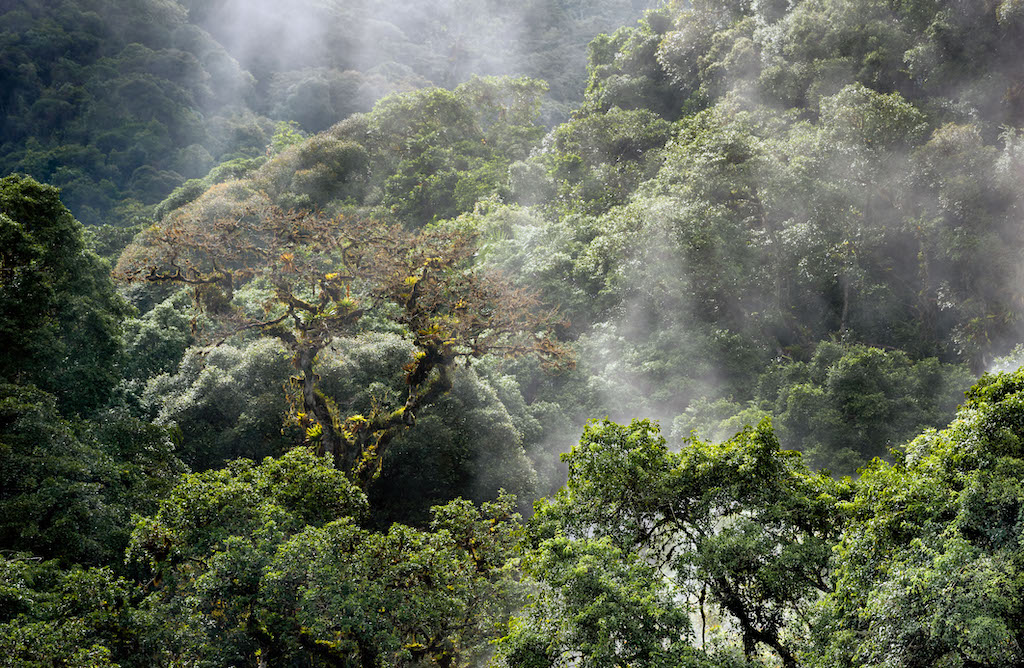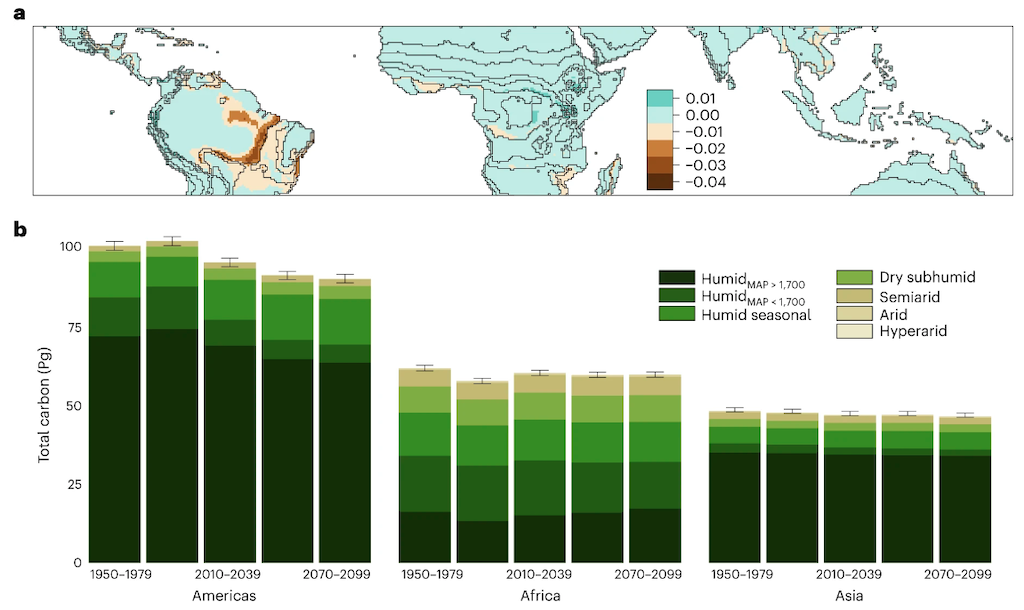
Tropical forests face ‘substantial carbon loss’ as humid areas contract
Yanine Quiroz
02.07.23Yanine Quiroz
07.02.2023 | 5:08pmThe reduction of humid regions in a warming climate could cause “substantial carbon loss” across the tropics by the end of the century, a new study finds.
The research, published in Nature Climate Change, assesses the potential changes in the distribution of wet and dry regions in tropical ecosystems by 2100 – under two different emissions scenarios – and the subsequent carbon loss that may occur due to these shifts.
The study projects a decrease in the extent of humid regions of tropical ecosystems and an expansion of areas with intense dry periods over the next several decades.
In a moderate-emissions scenario, the tropics could lose up to 12% of the carbon held in vegetation above the ground by the end of the century, the study finds. In a very high-emissions scenario, that percentage could nearly double, reaching up to 20% net carbon loss.
The study points to South America as the region that will be most affected by these changes; that continent alone would account for around 40% of this carbon loss.
The findings highlight the importance of conserving “the most carbon-rich ecosystems”, a researcher not involved in the study tells Carbon Brief. Without it, these ecosystems could “look very different to what we know them as today”.
Aboveground biomass
Tropical ecosystems cover 54m square kilometres of the Earth’s surface and are mainly distributed across South America, Africa and Asia.
Such ecosystems “sustain a very complex set of processes, actors and communities of animals [and] of biodiversity [more generally],” Dr Paulo Brando, a corresponding author of the study and an ecologist at Yale University, tells Carbon Brief.
All living vegetation that lies above the soil of those ecosystems – trees, leaves and grass – is called “aboveground” biomass. Over half of the world’s aboveground carbon is stored in tropical ecosystems, making them critical for mitigating climate change.

But carbon sequestration cannot occur without water. For that reason, the researchers examine the relationship between wet and dry zones in these ecosystems and how much carbon is stored in each climatic zone.
In wet zones, forests are dense and carbon-rich, in contrast with more arid regions, where forests have less biomass and therefore lower carbon storage.
The process by which wet zones become efficient carbon sinks is clear when looking at photosynthesis, says Dr Maria del Rosario Uribe, the lead author of the study and an ecologist at Yale University. She tells Carbon Brief:
“Plants need light, water and carbon from the atmosphere to [grow]. [They] transform it into biomass, so the more they have of these three, the more [carbon] they can capture. If you have a very long dry period, plants have to stop photosynthesis because they don’t have enough water.
“In the tropics, water is key, as there is a lot of light.”
Dr Michael Coe, a co-author of the study and the tropics programme director at the Woodwell Climate Research Center in Falmouth, Massachusetts, says water is important in tropical forests for another reason as well. He tells Carbon Brief that these ecosystems “recycle a huge amount of water – so they end up cooling the planet”.
Possible carbon loss
To understand how much carbon loss could occur in the future as a result of changes in the distribution of wet and dry areas, the authors analysed a range of tropical ecosystems: from forests to mangroves, savannahs and grasslands.
Tropical forests alone are responsible for 22% of the net carbon taken up by Earth’s land, the study notes.
First, the researchers categorised the extent of different climatic zones across the tropics – from “wet” to “hyper-arid” – taking into account average annual rainfall, temperature and a measure of dry season intensity.
Then, they considered two potential futures: a moderate-emissions scenario, RCP4.5, and a very high-emissions scenario, RCP8.5. Both scenarios project more intense dry periods in the future and less rainfall in the wettest tropical regions. This drying is especially notable in the Americas, as compared to Africa, Asia and Oceania.
The charts below show the changes of carbon in the tropics under the moderate-emissions scenario. The map displays the changes in carbon storage by the end of the century, with the largest reductions shown by dark brown shading. The bar charts break down the changes in carbon storage by timeframe, climatic zone and region.

The study finds that changes in climate have favoured the expansion of dry areas over wet ones between 1950-2009. Arid regions grew to encompass an extra 1.5% of the total tropics over that time.
The study projects that, under RCP4.5, humid tropical zones could decline by 3.2 percentage points by the end of the century, as compared to the baseline period of 1950-79. This would be a reduction from 48.9% of the tropics to 45.7%.
The study notes that while these are “relatively small” changes, the statistics “may mask complex dynamics”, such as expansion of humid areas in one region but a larger contraction in a different region. For example, they find that humid areas of Africa will increase by 0.6 percentage points, but this will be counterbalanced by a decline in the Americas of 4.2 percentage points.
As a result, even though small increases in tropical biomass may occur in some places, the researchers project that the largest carbon losses are likely to occur with the contraction of wet regions, mainly in the Americas.
Dr David Lapola, a researcher at the University of Campinas in Brazil, who was not involved in the study, points out that the people likely to be most affected by these changes are Indigenous people of the tropics. He also tells Carbon Brief that the study result is “not good news” for economic activities that depend on the hydrological cycle, such as fisheries, agriculture or energy generation.
The researchers also estimate how these changes could modify the amount of biomass that sits aboveground in tropical ecosystems, which allows them to quantify the potential changes in carbon storage.
Over the past 50 years, they find a decrease in aboveground tropical biomass, corresponding to a dip of around 1.5% from 1950 levels. Most of these changes occurred in semi-arid zones of Africa that shifted to even drier climates.
They project a carbon loss of 7-12% by 2100, compared to the 1950 baseline, in a moderate-emissions scenario. Under a high-emissions scenario, the carbon loss grows to 13-20%.
Uribe tells Carbon Brief that their study is an improvement over previous work due to the use of three different biomass datasets, which reduces the uncertainty associated with the biomass data.
For Dr Manan Bhan – another a researcher who was not involved in the research, but was a reviewer for the final paper – the team’s methods “are very innovative” as they combine biomass maps of the last two decades with climate models for this century.
Bhan, a fellow-in-residence at the Ashoka Trust for Research in Ecology and the Environment in India, tells Carbon Brief that other positive aspects of the study are that they use precise statistical approaches and describe the associated uncertainties, which are typically “significant” when it comes to biomass maps and climate models.
However, Lapola is sceptical about how much innovation the method poses, noting that this study reinforces evidence from previous research on the impacts of climate change on vegetation.
Tropical conservation
The authors note several factors that were not considered in their study, but may increase the biomass in the tropics – such as the climate adaptation of plants and natural and anthropogenic biomass recovery as a result of CO2 fertilisation or reforestation initiatives.
Lapola points out that there is a lack of field data about the effects of CO2 fertilisation in the tropics, and says that the authors “did the best we can do today [given] the uncertainties”.
There is still “significant debate” on the potential changes in tropical forests’ biomass, Bhan says. He explains that while biomass may increase due to factors such as CO2 fertilisation, it can decrease by threats some ecosystems could face or land-use change. He tells Carbon Brief:
“This is one more study in that direction in indicating the direction and magnitude of change. What is pretty clear is climate change will not affect the carbon storage capacities of all ecosystems equally.”
Another limitation of the study is that they only looked at aboveground biomass, says Brando. He tells Carbon Brief:
“There’s so much carbon stored in the soils that we are not accounting for.”
In addition to the warming climate, carbon loss in the tropics is caused by direct human-induced changes such as forest degradation, land-use change and ecosystem fragmentation.
For Coe, the most important action is to conserve the current tropical ecosystems. Once an ecosystem is lost, “it’s very hard to get it back”, he says, since large-scale ecosystem restoration is very expensive. He tells Carbon Brief:
“Protect, manage and restore – keep what you have and keep it in good health.”
Brando adds:
“Changes in climate that have happened and will have in the future are not large enough to destroy all tropical ecosystems…So it’s worthwhile to conserve them right now from deforestation, logging, fires and everything else we’re doing.”
Bhan agrees and urges “rapid and effective political action” to conserve some of the most carbon-rich ecosystems, especially those in South America, including the Amazon. Without doing so, these ecosystems “would look very different to what we know them as today”, he says, “and no amount of…afforestation would be able to compensate for that” loss.
Uribe, M. et al. (2023) Net loss of biomass predicted for tropical biomes in a changing climate, Nature Climate Change, doi:10.1038/s41558-023-01600-z



